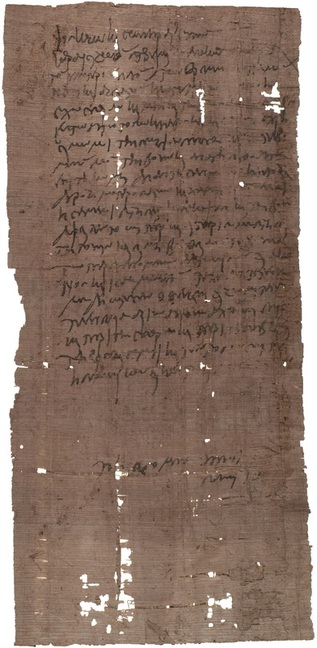 P.Col. 7.171
P.Col. 7.171 P.Col. 7.171 is a single sheet of well-preserved papyrus that was discovered in the ancient town of Karanis, Egypt. It is inscribed with the text of a petition dated to 6 June 324 C.E. Let's jump right into the text:
"To Dioskoros Caeso, praepositus of the 5th pagus, from Isidoros son of Ptolemaios, from the village of Karanis in your pagus. The cattle of Pamounis and Harpalos damaged the planting which I have and, what is more, [their cow] grazed in the same place so thoroughly that my husbandry has become useless. I caught the cow and was leading it up to the village when they met me in the fields with a big club, threw me to the ground, rained blows upon me and took away the cow—as indeed the (marks of) the blows all over me show—and if I had not chanced to obtain help from the deacon Antoninus and the monk Isaac, who happened by, they would probably have finished me off completely. Therefore, I submit this document, asking that they be brought before you to preserve my claim (to be heard) in the prefectural court both in the matter of the planting and in the matter of the assault. In the year of the consuls-to-be for the fourth time, Pauni 12."
There are several very interesting features of this papyrus. First, it should be noted that this papyrus is part of a larger cache of papyri (known as an "archive") belonging to Isidoros. We learn from some of his other petitions that Isidoros had a reoccurring problem with animals eating his crop. For example, in a document known as P.Cair.Isid. 78, dated five months prior to the papyrus under discussion, Isidoros summons the local police officers in Karanis to hunt down and arrest the owners of some animals who ate his crop. The owners of the animals are not mentioned in that papyrus, but it is possible that they belonged to Pamounis and Harpalos, who are mentioned in our papyrus. We can only imagine what caused this attack. Perhaps Pamounis and Harpalos were fed up with Isidoros going to the authorities about their cows and so wanted to make a point: "leave us and our cows alone and don't go to the police." Or perhaps it all started with a heated argument. I can just imagine Isidoros giving the two men a piece of his mind, to the point that they got fed up with him and took to fighting. Whatever the case, we learn that the two men beat him severely and left him in the wheat field.
Second, two good samaritans come to Isidoros' rescue: a Christian deacon and monk. This is historically important because it is the earliest secular reference to the term "deacon," as well as the earliest reference to "monachos" in the institutional sense of "monk," if we can indeed understand it in this way. Egyptian monasticism as a movement began roughly at the beginning of the fourth century with St. Anthony, and so we have here an extremely early reference to a monk, perhaps within a few decades of the very beginnings of monasticism. We know nothing about these men except their names and ecclesiastical titles, but Isidoros' citation of them suggests that a Christian institution was alive and well in (or near) Karanis in 324, a year of tremendous importance in the history of early Christianity. This was the year that Constantine the Great defeated Licinius, became sole ruler of the western and eastern empire, and upheld with fervor his support of Christianity empire-wide. One year later (325), Constantine convened the First Council of Nicaea. Thus, when read against the religious and political backdrop of 324, the petition of Isidoros takes on new meaning. At a time of civil war and heated debate about the place of Christianity within the empire, a Christian deacon and monk—ecclesiastical colleagues?—from a small farming town in Egypt emerge as good samaritans, representing the religion that was on the cusp of exploding across the Roman empire and the entire western world.
Several open-ended questions
* Isidoros mentions the monk and deacon by name. Would the prefect have known who they were?
* Whatever happened to Isidoros? This is the latest dated document from his archive so we learn nothing more about him.
*What was the relationship between the deacon and monk? Obviously, Isaac could not have been a desert ascetic, since he is here associated with a Church clergyman.
*How do we understand "monk" in this case (admittedly a bigger and perhaps more important historical question)?
